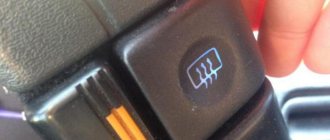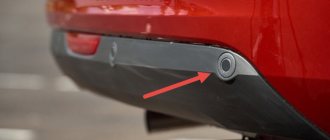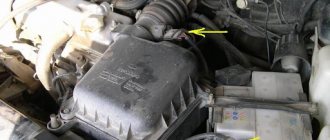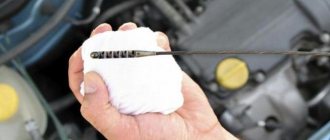Heated rear window of VAZ 2115 does not work
I bought myself such a gadget :)
The relay is designed to turn on the heated rear window for a fixed time when voltage is applied to the “winding” of the relay. It is used on VAZ 2104-2115, Niva, Priora, Kalina cars, in which the rear window heating relay (type 90.3747-10) is installed in the standard relay and fuse block and the relay is controlled by a plus. The relay is available with a built-in timer and has the ability to manually adjust the operating time. Adjustment is carried out using a tuning multi-turn resistor through a hole in the relay housing. The timer operating time is from 1 to 30 minutes.
INSTALLATION AND CONNECTION
Install the relay in the relay and fuse box in place of the standard rear window heating relay.
Connect the wire with the fuse tap coming out of the relay housing to the vehicle's on-board network. To do this, you need to remove one of the standard fuses, on which a “+” appears after turning on the ignition. I connected the turn signal relay to the power fuse in maneuvering mode,
by inserting it into the free (lower) connector of the coupler
and install the fuse tap in place of the removed fuse.
Almost all VAZ models have heated rear windows, which makes driving the car much easier in special conditions. Most often, heating is needed in bad, cloudy weather, when the rear window fogs up from the condensation that forms, as well as in winter, when the glass becomes covered with ice.
The operating principle of the heater is quite simple:
- a conductive thread of a certain resistance is applied to the rear window, which heats up when current passes through it;
- supply voltage is provided by the following components: wiring, relay, fuse and power button;
This scheme is used on all VAZ cars (as well as on most foreign cars), from the “classics” to the latest models.
Other causes of malfunction
Despite the simplicity of the design of the heating system, it includes a number of elements that can break over time. The power button, wiring, heating filaments, pres and relays - all these parts, if broken, do not allow you to use heating. If after checking the fuse and relay box you still cannot find the cause, check out the list of other possible faults:
- Oxidation of contacts in the installation compartment;
- Broken wiring;
- Breakage or partial damage of threads on the plane;
- Mechanical failure of the system.
The reason, invisible during a cursory diagnosis, is a broken wiring. Without a multimeter, it is difficult to determine the exact location of the break. The heating filaments are quite fragile, so you should be careful when interacting with the inside of the glass. Often when tinting a car, these threads are damaged. Resoldering and restoration takes a long time, so this function does not work in many “fours”. Minor faults are not critical and are repaired when the exact location of the breakdown is identified. The design does not require any maintenance, but you should be careful when interacting with the heating filaments.
Source
Design of the rear window heating system
The system that helps clear the rear window of ice, snow or fog is not very complicated in design. The electrical circuit in general terms can be depicted as follows:
- C - generator.
- E230 - OZS system switch.
- J519 - on-board electrical network control unit.
- Z1 - heating element of the OZS system.
Although there may be some differences in different car models, nevertheless, if we consider it in detail, then in principle it includes the following main elements.
- Mounting block.
- Ignition switch.
- Heating switch ZS.
- Indicator lamp signaling the activation of the OZS.
- Heating element of the OZS system.
K6 - additional relay. K7 - OZS switching relay. A - connection to power systems.
In addition, the system has fuses, terminals and wires that connect all elements into a single whole.
When the ignition key is turned, the OZS is turned on by pressing a button, to which power is supplied through an additional relay K6. At the same time, the rear window heating relay K7 is activated, the heating element is connected and at the same time the control light comes on.
The design of the heating element on the rear window may also vary. In the standard version, it is a mesh of thin metal nickel threads, which are connected by two conductive busbars located on opposite sides. On one side, a 12V current is supplied to the bus, and on the other, the bus is shorted to ground. Such devices are attached to the glass using special glue.
On some car models, the heating element is applied to the glass using spraying, for example, aluminum. A thin film with good light transmission is attached on top of this coating using glue that conducts current.
Eliminating the break
Patching a cliff in general is not a difficult task, and there are several ways to solve it.
The most commonly used is electrically conductive paste. Before repairing, it will be necessary to secure the broken area with adhesive tape (two pieces - one for each fragment of the track). The ends of the thread are cleaned and washed with alcohol. The paste is then applied to them and left to dry for at least 24 hours. You can also restore the functionality of the rear window heating element using:
- glue (type BF);
- metal filings;
- magnet
How to find a breakdown
To find out exactly what the reasons for the failure are, you only need a standard voltmeter, which every self-respecting car enthusiast should have.
By simple manipulations with this measuring device, the problem will be identified very quickly. You should start checking the heating element filaments with the following steps:
- the metal tips of the probes are wrapped in tin foil (this will avoid damage to the tracks);
- turn on the ignition;
- check whether the heating button is pressed;
- one probe is applied to the plus of the heating element mounted on the rear window;
- the second is installed approximately in the center of the thread.
If the device shows 6 volts, this means that there is no damage in this area. If the tester produces 12 volts, the gap is located somewhere in the segment between the probes.
If there are 10 volts, we can confidently say that the gap is located between the minus and the center of the track. In this situation, connecting one probe to the negative output will allow you to more accurately determine where the damage is located. At the same time, the second one must be carefully guided along the thread from the plus to the opposite end. Finding the exact location of the break is indicated by an increase in voltage from zero to 5 volts.
If you don’t have a voltmeter at hand, then the break will also be easy to find visually. To do this, you will need to wait until the windows in the car fog up, and only then turn on the heating. Where the track remains operational, the moisture will begin to evaporate noticeably. Condensation will remain in de-energized areas. It is these sections of the heating element that will need to be examined in detail. To do this you will need a magnifying glass.
If the heating is completely out of order, it can be replaced with a removable model, which is attached to the glass using special suction cups. It is connected to the car's electrical network, like many other devices, through the cigarette lighter.
There are also modifications on sale in which an additional fan is installed. But this option is not very practical because it requires too much electricity.
Engine control diagram for VAZ 2111 - Euro-2 (Bosch MP7.0)
- Fragment of the mounting block;
- Electric engine cooling fan;
- Automotive anti-theft system status indicator;
- Automotive anti-theft system control unit;
- Coolant temperature sensor;
- Air flow sensor;
- Throttle pipe;
- Block connected to the throttle position sensor;
- Block attached to the idle speed control;
- Controller;
- A block connected to the air conditioner wiring harness;
- Oxygen sensor;
- Knock sensor;
- Crankshaft position sensor;
- Speed sensor;
- Adsorber;
- Accumulator battery;
- Main relay;
- A block connected to the anti-lock brake system wiring harness;
- Diagnostic block;
- Main relay circuit protection fuse;
- Controller protection fuse;
- Fuse for protecting the electric fuel pump and its relay;
- Relay for turning on the electric fuel pump;
- Electric fan switch relay;
- A block connected to the instrument panel wiring harness;
- A block connected to the instrument panel wiring harness;
- Ignition module;
- Electric fuel pump with fuel level sensor;
- Spark plug;
- Injectors.
- F — Front harness wire going to the “B+” terminal of the generator; G - Front wiring harness wires.
The order of conditional numbering of plugs in blocks:
- A - Controller;
B — Control unit of the automobile anti-theft system;B — Indicator of the status of the automobile anti-theft system;
G - Pads 26;
D - Throttle pipe;
E - Air flow sensor;
F - Electric fuel pump and oxygen sensor;
3 — Speed sensor;
And - Ignition module.
Purpose of plugs in block 26:
- To the low-voltage tachometer input in the instrument cluster;
- —
- To the engine management system control lamp in the instrument cluster (from the controller);
- To the dome light switch located on the driver's door pillar;
- To the engine control system control lamp in the instrument cluster (+ power supply);
- To the trip computer (fuel consumption signal);
- To the instrument cluster (vehicle speed signal);
- To terminal “15” of the ignition switch (plug 4 of the switch block)
DIY heating repair
I remember distant times when this was practically impossible! Now technology has come so far - you can buy a rear window repair kit just to restore these narrow strips. I suspect that there is some kind of metallized composition or paint - but it is called conductive glue.
This glue can withstand temperatures from – 60 to + 100 degrees Celsius. This is exactly what we need to buy. The only thing I want to tell you is - don’t take the cheapest composition, now in my opinion it’s about 150 - 200 rubles, take a little more expensive one, about 300 - 400 rubles, such compositions work much longer.
Purpose and design
The purpose of the rear window heater can be judged by the very name of the system - by heating it fights condensation that settles on the surface, the cause of which is the difference in temperature in the cabin and outside.
In the autumn-spring period, this condensation causes “fogging” (a water film is formed, which greatly limits visibility), and in winter it turns into ice and frost, through which it is generally impossible to see what is happening behind.
As for the side mirrors, they are located outside and should not “fog up” or freeze, since there is no temperature difference as such. But there are other reasons why a water film and frost form on the surface of the mirror, reducing visibility.
Source
Repairing the heated rear window - how and with what?
- There are many options for repairing threads, one of which is a repair kit for rear window heating threads. This category is represented on the market by: Permatex and Quick. Such repair kits allow you to effectively restore large areas of ruptures, up to ten centimeters. The kit consists of stencils, a can of polymer resin, and the heating filaments themselves. The repair proceeds as follows: we find the damaged area, prepare the required piece of thread, remove the protective film and glue the thread to the area using polymer resin. When everything is dry, the procedure can be repeated. After 1-2 days, turn on the heating and check the result.
- The second way to fix heated rear window threads is to use conductive paste, such as Kontaktol. A special paste or glue that is capable of conducting current is applied in a thin, neat layer to the damaged area. For more precise application of the paste, the work area can be covered with tape. The paste takes about a day to dry, but if you have effective heat sources such as a hair dryer or a special heater, the drying time can be significantly reduced.
- There are also alternative “homemade” methods for repairing the heated rear window. So, some people use paint to which they add copper-brass shavings. The paint is matched to the color of the threads, and the shavings are obtained by planing the material. You can use glue instead of paint. Alternatively, you can try to connect the break points using a soldering iron. I would like to note that in this case there will be a result, but it will not look entirely aesthetically pleasing.
I will end here. I hope now you know what rear window heating is, how to find its fault, and how to repair heated glass in different ways. That's all I have, thank you for reading to the end. I would be grateful if you share this article on social networks, this will help us in the development of this project. In addition, more people will know about our existence. Also, don’t forget to leave your comments and add your own tips to this article. All the best and see you again at VAZ Repair.
Methods for repairing heating element filaments
There are several ways to restore the functionality of a heating filament at home.
Using conductive pastes and adhesives
The easiest and most effective way is to use special repair kits, such as DONE DEAL DD6590, designed to repair rear window defroster threads and contacts by both amateurs and professionals. The good thing about this method is that it does not require tools or materials. It is enough to apply a little conductive paste from a syringe to the site of the thread break according to the attached instructions, wait until the paste hardens and the repair is completed. But this set costs more than $15.
The second method is similar to the previous one. But instead of a proprietary set, they use purchased conductive adhesives, for example, Elekont, a Moscow manufacturer. Glue is applied to the place where the thread breaks, overlapping the entire part of the thread by a centimeter on each side. To obtain a neat look, use a stencil made of electrical tape or adhesive tape. For reliability, the glue is applied twice. It is advisable to lay a piece of tinned copper wire with a diameter of 0.3-0.5 mm between the layers of conductive glue.
There is an opinion that conductive paste or glue for repairing glass heater filaments can be made independently by mixing paint or glue with brass filings in a one-to-one ratio. The resulting composition is applied in a thin layer through a stencil to the place where the thread breaks in several layers. But the reliability of this technology has not been confirmed by practice.
Electroplated copper deposition
Another method is galvanic copper deposition. The heater filament repair method seems attractive. But from personal experience I can say that the reliability of such coatings at home is low. So I was hesitant to use this technology.
Using soft soldering
A mechanical method of restoring the integrity of the rear window heater filaments, using soft soldering, has become widespread. I tested the reliability of this method when repairing rear window heating filaments in my own car. The step-by-step instructions below, written based on my experience, will allow you to easily repair the heater filament yourself in just a few minutes, with virtually no financial costs.
On the advice of theorists on the Internet, I made a big mistake and tried to clean the thread with sandpaper. As a result, instead of a break in the thread 1 mm wide, there was a break larger than 1 cm. The thread strip is very thin, only a couple of tens of microns, and can be erased instantly even with the finest-grained sandpaper. The heater threads are already not covered with anything, and it is enough to degrease the soldering area using a rag soaked in alcohol or acetone.
If the width of the thread break is less than 1 mm, then you can do without soldering an additional conductor. In my case, the width of the gap was large, and I had to first prepare a piece of copper wire for the jumper. A current of about 1 A flows through one thread of the heater. Based on this, we select a wire with a cross section of 0.17 mm2 from the wire cross-section table, which corresponds to a diameter of 0.45 mm. The length of the copper jumper must be equal to the width of the thread break plus 2 cm. Before soldering, the jumper must be tinned with a thick layer of POS-61 tin-lead solder. There is no need to tin the heater thread.
In order for the solder to reliably adhere to the heater thread, before soldering the jumper, you need to lubricate the thread in the soldering zone with a thin layer of zinc chloride flux using a brush.
Next, the jumper is pressed against the heating thread and heated for one second with a 12 W soldering iron. The hand is moved to the side. The jumper should be held on by a thread. Trying to tug it to check the quality of soldering is unacceptable; it will fall off and also tear off a piece of the heater thread. Unfortunately, this has been verified empirically. As a result of experiments, I eventually had to solder a jumper 5 cm long.
What to do if the rear window heating does not work (VAZ 2109, 2110, 2114)
Sometimes we find ourselves in a situation where the rear window heating does not work. What to do - more on that below. First, let's look at the causes of the malfunction.
The most common reasons may be as follows.
- The fuse has blown. Option - there is no contact with it in the sockets. Actually, the check should begin with replacing the fuse, even if visually it looks intact.
- The switch has failed.
- The relay has “flyed”.
- There is no contact at the heater terminals.
- Break in the wiring.
- Breakage of the heater filaments themselves.
Armed with a car tester, with certain skills, all these defects in the rear window heating can be detected.
Now specific answers to the question: the heated rear window does not work - what should the owner of the car do in such a situation (no matter what domestic model - VAZ 2109, 2110 or 2114)?
Regarding the first four points, if the tester “found” them, there should be no questions. A malfunction has been identified and needs to be fixed, which is understandable.
What to do next ? There are two ways to go.
- Replace the stationary heated rear window with a removable version (with suction cups) connected via the cigarette lighter. Or install a heater with a fan (not a very rational option, given the subsequent increased current consumption).
- Restore the conductive threads if the rear window heating does not work. There are many ways to do this. So what to do in this situation? What methods of “treatment” are there?
- “Patching” the breakage area with conductive paste. The place needs to be localized with two pieces of adhesive tape. Connect the ends of the conductor, stripped and washed with alcohol, with paste and let dry for a day.
- Restoring the heated rear window using glue and a magnet. You will need homemade sawdust, which needs to be “planed” with a file. The magnet can be taken from any broken speaker, the glue is BF-2 or its equivalent. The magnet is placed on the reverse side at the breakage site, the sawdust is placed on the side of the thread. Next, coat the “joint” with varnish.
- Electrolytic method. You will need sulfuric acid and copper sulfate. The method is quite labor-intensive; the point is to redirect copper ions from the copper electrode to the heating element.
- Sometimes soldering is used if you use zinc chloride as a flux, and use low-tin solder (POSS-4-6, POS-18). This is the case if the break is point-like. If it is large-scale, it is better to “patch” it with silver or copper wire.
There are special adhesives for restoring heating filaments. They are not particularly popular yet.
In principle, these are the main methods and algorithms that need to be used if the rear window heating does not work. Now the question - what to do - will not confuse you.
Most common reasons
It is worth noting that the heated rear window most often does not work in a VAZ-2115 car for the following reasons:
- fuse is blown;
- there is no contact at its terminal;
- The toggle switch that turns on the heating is broken;
- the relay has become unusable;
- contacts on the terminals of the heater circuit have oxidized;
- The threads have broken.
Fuses blow out quite often. This usually happens unnoticed by the car owner.
As a result, one or another device stops working. For this reason, you should pay attention to them first of all if you do not want to join:
- cigarette lighter;
- stove;
- burnout installed on the rear window, etc.
Replacing them with serviceable ones will solve the problem completely. In other cases, it will also be necessary to clean the terminals from dirt, and at least visually make sure that the power wires have not come off the buttons. If the relay is faulty, then it will need to be replaced - it is not very expensive and is quite easy to install.
Car electrical equipment
1 – headlight block; 2 – gearmotors for headlight cleaners*; 3 – fog lights*; 4 – ambient temperature sensor; 5 – sound signals; 6 – engine compartment lamp switch; 7 – electric motor of the cooling system fan; 8 – VAZ 2114 generator; 9 – low oil level indicator sensor; 10 – washer fluid level sensor; 11 – front brake pad wear sensor; 12 – wire tips connected to the common glass washer pump**; 13 – windshield washer pump; 14 – headlight washer pump*; 15 – wire ends for connecting to the rear window washer pump on VAZ 2113 and VAZ 2114 cars; 16 – low oil pressure indicator sensor; 17 – engine compartment lighting lamp; 18 – wire lug for connection to the wiring harness of the engine management system or to the wiring harness of the ignition system on carburetor vehicles; 19 – windshield wiper gearmotor; 20 – VAZ-2114 starter; 22 – coolant temperature indicator sensor; 23 – reverse light switch; 24 – indicator sensor for insufficient brake fluid level; 25 – battery; 26 – sensor for insufficient coolant level indicator; 27 – relay for turning on fog lights; 28 – mounting block; 29 – brake light switch; 30 – plug socket for a portable lamp; 31 – illumination lamp for the headlight hydrocorrector scale; 32 – parking brake warning lamp switch; 33 – backlight lamp connection block; 34 – switch for instrument lighting lamps; 35 – steering column switch; 36 – alarm switch; 37 – front seat heating element relay; 38 – ignition switch VAZ 2114; 39 – rear fog light circuit fuse; 40 – fuse for the front seat heating elements circuit; 41 – door lock circuit fuse; 42 – front ashtray illumination lamp; 43 – ignition relay VAZ-2114; 44 – cigarette lighter; 45 – glove box lighting lamp; 46 – glove box lighting switch; 47 – heater fan electric motor; 48 – additional resistor of the heater electric motor; 49 – heater fan switch; 50 – heater switch illumination lamp; 51 – backlight lamp for heater levers; 52 – gearmotors for electric windows of the front doors; 53 – power window switch for the right front door (located in the right door); 54 – gearmotors for locking front door locks; 55 – wires for connecting to the right front speaker; 56 – gearmotors for locking rear doors; 57 – wires for connecting to the right rear speaker; 58 – door lock control unit; 59 – wires for connecting to radio equipment; 60 – headlight cleaner switch; 61 – rear window heating element switch; 62 – relay for turning on rear fog lights; 63 – block for connection to the heating element of the right front seat; 64 – switch for rear fog lights: 65 – switch for the heating element of the right front seat; 66 – fog lamp switch; 67 – switch for external lighting lamps; 68 – left front seat heating element switch; 69 – block for connection to the heating element of the left front seat; 70 – wires for connecting to the left front speaker; 71 – left front door power window switch; 72 – right front door power window switch; 73 – wires for connection to the left rear speaker; 74 – side direction indicators: 75 – lamp switch on the front door pillars; 76 – lamp switch on the rear door pillars; 77 – lampshade; 78 – canopy for individual interior lighting; 79 – block for connecting to the wiring harness of the VAZ 2114 electric fuel pump; 80 – trunk light switch; 81 – instrument cluster: 82 – trunk lighting lamp; 83 – display unit of the on-board control system; 84 – trip computer (not in all models); 85 – block for connecting the wiring harness of the engine control system; 86 – rear external lights of the VAZ-2114; 87 – rear internal lights; 88 – block for connection to the rear window heating element; 89 – license plate lights; 90 – additional brake signal located in the spoiler.
In the instrument panel wiring harness, the second ends of the white wires are brought together into one point, which is connected to the instrument lighting switch (except for the white wire, from plug “4” of block “X2” of mounting block 28 to display block 83 of the on-board control system). The second ends of the black wires are also brought together to points connected to ground. The second ends of the yellow wires with a blue stripe are brought together to a point connected to plug “4” of the “X1” block of the mounting block. The second ends of the white wires with a red stripe are brought together to a point connected to plug “10” of the “X4” block of the mounting block. And the second ends of the orange wires are also brought together to a point connected to plug “3” of the “X4” block.
Engine control circuit for VAZ 2111 (January 5.1, Bosch M1.5.4N)
- Fragment of the mounting block;
- Electric engine cooling fan;
- Automotive anti-theft system status indicator;
- Automotive anti-theft system control unit;
- Coolant temperature sensor;
- Air flow sensor;
- Throttle pipe;
- Block connected to the throttle position sensor;
- Block attached to the idle speed control;
- Controller;
- A block connected to the air conditioner wiring harness;
- Oxygen sensor;
- Knock sensor;
- Crankshaft position sensor;
- Speed sensor;
- Adsorber;
- Accumulator battery;
- Main relay;
- A block connected to the anti-lock brake system wiring harness;
- Diagnostic block;
- Main relay circuit protection fuse;
- Controller protection fuse;
- Fuse for protecting the electric fuel pump and its relay;
- Relay for turning on the electric fuel pump;
- Electric fan switch relay;
- A block connected to the instrument panel wiring harness;
- A block connected to the instrument panel wiring harness;
- Ignition module;
- Electric fuel pump with fuel level sensor;
- Spark plug;
- Injectors;
- F — Front harness wire going to the “B+” terminal of the generator; G - Front wiring harness wires.
The order of conditional numbering of plugs in blocks:
- A - Controller;
B — Control unit of the automobile anti-theft system;B — Indicator of the status of the automobile anti-theft system;
G - Pads 26;
D - Throttle pipe;
E - Air flow sensor;
F - Electric fuel pump and oxygen sensor;
3 — Speed sensor;
And - Ignition module.
Purpose of plugs in block 26:
- To the low-voltage tachometer input in the instrument cluster;
- —
- To the engine management system control lamp in the instrument cluster (from the controller);
- To the dome light switch located on the driver's door pillar;
- To the engine control system control lamp in the instrument cluster (+ power supply);
- To the trip computer (fuel consumption signal);
- To the instrument cluster (vehicle speed signal);
- To terminal “15” of the ignition switch (plug 4 of the switch block)
Possible repair options
All the damage described above, due to which the rear window heating of the VAZ 2114 does not work, is quite common and can be eliminated without much expense or extra effort. A much bigger problem is damage to the heater itself, namely the breakage of its heating filaments.
If this happens, then you can follow several ways to solve the problem:
- restore broken threads yourself;
- install a small removable heater connected to the cigarette lighter;
- install a full-fledged glass heater with a fan.
If the conductive threads break, the best option is to restore them. Installing additional heating elements in a car can greatly increase the load on its on-board network.
In order to detect the exact location of the break, you should carefully examine all the threads under a magnifying glass.
After the break is found, you can try to restore the heating in one of the following ways:
- Connect the cleaned areas with a paste made of conductive material.
- Make the connection using small metal filings. To do this, sawdust is applied to the break site, and a powerful magnet is placed on the other side of the glass, which will temporarily hold it. While the sawdust is attracted by the magnet, you should quickly apply a layer of varnish or BF type glue to them.
- Solder the break point with POS-18 solder or similar (low tin content).
- Seal the gap with a special glue for restoring heating filaments (it should be noted that it is quite rare and is not found in all car shops).
By performing repairs in this simple way, you can completely restore the functionality of the glass heating system, even if there are numerous breaks.
Damage to threads
Electric strips act as current conductors, heating up slightly due to resistance (the strips are connected in parallel - the voltage is distributed evenly). If even one heating strip is damaged, the current stops circulating in the system - the heating does not work.
To restore the heating strips, you will need to buy a special repair kit from a car store (do not buy the cheapest one, so as not to run into a low-quality product).
The set includes:
- special glue with high electrical conductivity (choose by color so that the “restored” area does not stand out);
- a brush for applying it;
- tape to mark boundaries.
Find the location of the chain break (often mechanical damage). Study the instructions for the restoration kit, pay attention to the drying time and the recommended method of application. Prepare the damaged area for repair - wipe it with alcohol using a lint-free, clean rag (remove dirt and grease). Apply strips of tape in the area of the tear on both sides of the tape (leave the appropriate width). Apply the special product in several layers (see the instructions for the quantity). Let the glue dry - often a day is enough. After this, remove the tape and check the operation of the unit.
This method is suitable for repairing rear window heating in domestic cars (for example, VAZ 2114, VAZ 2112, VAZ 2107, VAZ 2109, Lada Granta).
There are two more alternative methods for restoring a break:
- Using metal filings. You will need sawdust, a magnet and clear glue (preferably some tape). Description of the process: attach the magnet to the back side, pour sawdust onto the damaged area from the inside. Place tape under the bottom of the strip to prevent any metal shavings from sliding off. We fix the material on top with glue. Let it dry. Ready!
- The point here is that they use a mixture of non-ferrous metal shavings and paint. This substance should be identical in density to plasticine. Next, fix the tape, as in the previous version, and heat it up. Apply the material to the damaged area and wait half an hour (hissing is normal). Allow the glass to cool for another hour before using the heating fully.











